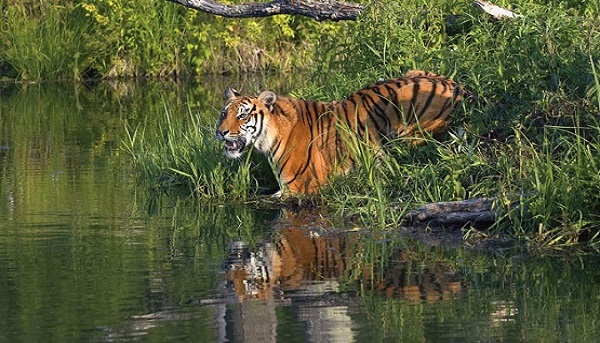The Sundarbans, the largest mangrove forest in the world, is a unique and biodiverse region situated near Kolkata. This majestic mangrove wonderland is home to the elusive and iconic Royal Bengal Tiger, along with a myriad of other wildlife species. Spanning over 10,000 square kilometers across India and Bangladesh, the Sundarbans are renowned for their intricate network of waterways, mudflats, and dense mangrove forests. The Sundarbans’ rich history, complex ecosystem, and the interplay of its flora and fauna make it a captivating destination for nature enthusiasts and adventure seekers. In this blog, we will delve into the enchanting world of the Sundarbans, exploring its history, wildlife, and the experiences it offers to visitors. It will definitely mesmerize anyone with its beauty and uniqueness and give an unforgettable experience full of fun, enjoyment, and adventure.
The History and Significance of the Sundarbans
- Ancient Origins
The Sundarbans have a rich historical background dating back to ancient times. The name “Sundarbans” is derived from the Sundari trees (Heritiera fomes) that dominate the region. Historically, the area has been a site of human settlement, trade, and cultural exchange, with records of its existence found in ancient texts and maritime logs. The region has always been a point of interest for explorers and naturalists, fascinated by its unique environment and diverse wildlife. Its unique features attract a large number of visitors every year and they do not regret coming here, their curiosity ends here and they get all the answers they need to know about this unique green marvel.
- Ecological Importance
The Sundarbans play a crucial role in the ecological balance of the region. The mangroves act as a natural barrier against coastal erosion, storm surges, and tsunamis, protecting the inland areas. The complex root systems of the mangrove trees stabilize the coastline and reduce the impact of natural disasters. Additionally, the Sundarbans are a UNESCO World Heritage Site, recognized for their unique biodiversity and the critical habitats they provide for numerous species, including endangered ones.
- Cultural Significance
The Sundarbans hold cultural significance for the local communities who have lived in harmony with the forest for centuries. The folklore, traditions, and rituals of the inhabitants are deeply intertwined with the natural environment. The Bonbibi cult, which worships the forest goddess Bonbibi, is a testament to the deep-rooted cultural connection between the people and the forest. Festivals and rituals celebrating the forest and its deity are integral to the cultural fabric of the Sundarbans. These cultural festivals are also an important reason to visit here, witness its beauty and have a wonderful experience.
The Royal Bengal Tiger: The Majestic Predator
- The King of the Mangroves
The Royal Bengal Tiger (Panthera tigris tigris) is the most celebrated inhabitant of the Sundarbans. Known for its strength, agility, and elusive nature, this apex predator reigns supreme in the mangrove forests. The tigers of the Sundarbans have adapted to their unique environment, often swimming between the islands and developing distinct hunting techniques to catch their prey. These tigers are known for their swimming prowess and can cover considerable distances in water, making them unique among tiger populations. One of the main reasons to visit Sunderbans is to see this agile and graceful animal and admire its beauty, which is available only here.
- Conservation Efforts
Conserving the Royal Bengal Tiger is a priority for wildlife organizations and the Indian government. Various initiatives, including anti-poaching measures, habitat preservation, and community engagement, are in place to protect this endangered species. The Sundarbans are patrolled by forest guards, and several NGOs work tirelessly to monitor tiger populations and mitigate human-wildlife conflict. Visitors to the Sundarbans can contribute to these efforts by supporting eco-friendly tourism and adhering to guidelines set by conservation authorities. Participating in responsible tourism practices helps ensure that the natural habitat of the tigers remains undisturbed. Everyone should actively participate in this work so that every endangered animal can be saved, because if they are fine then the forest will be fine and only then we will also be fine. Forests are an important part of our life and they are an important part of the forest. So we should protect both.
Exploring the Biodiversity of the Sundarbans
- Flora and Fauna
The Sundarbans are a biodiversity hotspot, boasting a wide range of plant and animal species. Apart from the Royal Bengal Tiger, the forest is home to saltwater crocodiles, Indian pythons, spotted deer, and various bird species such as the lesser adjutant stork and white-bellied sea eagle. The mangroves themselves are a diverse ecosystem, with several species of trees and plants adapted to the saline environment. The intricate root systems of the mangrove trees provide a habitat for numerous aquatic species, including fish, crabs, and mollusks. This diversity of flora and fauna is what makes it different from others.
- Aquatic Life
The waterways of the Sundarbans are teeming with aquatic life. The region is home to the rare and endangered Irrawaddy dolphin, as well as the Ganges river dolphin. The estuarine waters support a rich diversity of fish species, many of which are commercially important. The mudflats and tidal creeks provide a nursery for many marine species, making the Sundarbans an essential part of the marine ecosystem.
- Bird Watching Paradise
Bird enthusiasts will find the Sundarbans a paradise, with its rich avian diversity. Migratory birds flock to the region during the winter months, adding to the already impressive array of resident bird species. Common sightings include kingfishers, herons, and egrets, making the Sundarbans a prime location for birdwatching. Birdwatching tours, led by experienced guides, offer a chance to spot and learn about the diverse bird species that inhabit the mangroves.
- Unique Adaptations
The flora and fauna of the Sundarbans exhibit unique adaptations to survive in the challenging environment. The mangrove trees have specialized root structures, such as pneumatophores, that enable them to breathe in waterlogged conditions. The wildlife, including the tigers, have adapted to the brackish water and the dense, tangled vegetation. These adaptations make the Sundarbans a fascinating study in resilience and survival.

Adventure and Eco-Tourism in the Sundarbans
- River Cruises and Safari Tours
One of the best ways to explore the Sundarbans is through river cruises and safari tours. These guided tours offer a chance to navigate the intricate network of rivers and creeks, providing glimpses of wildlife and the stunning mangrove landscape. Knowledgeable guides share insights into the ecosystem, making the experience educational and memorable. The boat safaris allow visitors to access remote areas of the forest that are otherwise difficult to reach, increasing the chances of wildlife sightings. This unique and serene beauty of Sundarbans makes it one of the must visit destination around Kolkata. 
- Trekking and Nature Walks
For the more adventurous, trekking and nature walks offer an immersive experience of the Sundarbans. Accompanied by experienced guides, visitors can explore the forest trails, learn about the local flora and fauna, and enjoy the serene beauty of the mangroves. These guided walks provide an opportunity to see the forest up close and understand the delicate balance of the ecosystem. Trekking and nature walks in Sundarbans are such an amazing opportunity to learn more about this gem. So coming here is not a bad idea. You must visit here whenever you feel like trekking.

- Sustainable Tourism Practices
Promoting sustainable tourism is essential to preserving the delicate balance of the Sundarbans. Eco-friendly practices such as minimizing plastic use, respecting wildlife habitats, and supporting local communities contribute to the conservation of this unique environment. Visitors are encouraged to choose responsible tour operators and accommodations that prioritize sustainability. By practicing responsible tourism, visitors can help ensure that the Sundarbans remain a pristine natural wonder for future generations. It is also the duty of the visitors to follow the rules of conservation of forests and to promote and follow eco-friendly practices.

- Community-Based Tourism
Community-based tourism initiatives in the Sundarbans involve local communities in the tourism industry, providing them with a source of income and encouraging them to protect their natural environment. Homestays, local guides, and community-run eco-lodges offer visitors an authentic experience while supporting the livelihoods of the local population. So that anyone coming here does not face any problem in staying, or any other thing everything is available for our comfort.

The Sundarbans, with its majestic mangroves, diverse wildlife, and rich history, is a natural wonder that beckons travelers seeking an immersive and unforgettable experience. Whether you’re tracking the elusive Royal Bengal Tiger, birdwatching, or simply marveling at the beauty of the mangroves, the Sundarbans offer a glimpse into one of the world’s most fascinating ecosystems. As we explore and appreciate this wonderland, let us also commit to its preservation for future generations to enjoy. Responsible tourism, conservation efforts, and community engagement are key to ensuring that the Sundarbans continue to thrive. So whenever you want to experience adventure and looking for something thrilling then you must visit this green marvel near Kolkata which will surely give you a wonderful experience filled with joy, thrill and awe and this place is also for nature lovers and bird lovers who find it fascinating can also come here.
FAQs
Q1: How can I reach the Sundarbans from Kolkata?
A: The Sundarbans can be reached from Kolkata by road and boat. The journey typically involves a drive to one of the embarkation points such as Godkhali, followed by a boat ride into the forest.
Q2: What is the best time to visit the Sundarbans?
A: The best time to visit the Sundarbans is between November and February when the weather is cooler and more pleasant. This period is also ideal for wildlife sightings, including migratory birds.
Q3: Are there accommodations available in the Sundarbans?
A: Yes, there are several eco-resorts and lodges in the Sundarbans that offer comfortable accommodations. These establishments often provide guided tours and activities for visitors.
Q4: Is it safe to visit the Sundarbans?
A: Visiting the Sundarbans is generally safe when done through authorized and experienced tour operators. It is important to follow safety guidelines and respect wildlife to ensure a safe and enjoyable experience.
Q5: Can I see the Royal Bengal Tiger in the Sundarbans?
A: While the Royal Bengal Tiger is present in the Sundarbans, sightings are rare due to their elusive nature. However, the experience of exploring their habitat and the possibility of a sighting adds to the thrill of the visit.

